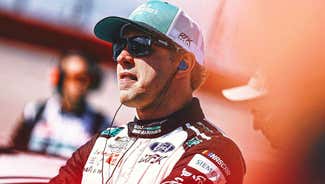
Are the Sprint Cup cars too fast?
While there might not be a lot of on-track activity, trust me when I tell you there is a lot of work by all the NASCAR Sprint Cup teams going on in the shops on this new car. It’s obviously created a lot of work for everyone to make the switch over to it, but at the same time it has created a lot of excitement in and out of our sport.
One of the ongoing debates that I have been paying attention to is the question of whether or not the NASCAR Sprint Cup cars are going too fast. From what I am hearing, the general consensus is these cars are going so fast that it is affecting the quality of racing. You know, in some ways, I guess I have to agree with that.
Think about this: When you barrel down into the corner of Charlotte Motor Speedway, Atlanta or any other of these mile and a half tracks, with cars all around you, it makes your car edgy. We hear about aero push all the time, but I think some of the problem is these cars are going so fast, they need more track to be able to maintain those fast speeds.
I really believe some of that aero push is simply too many cars together going extremely fast in a limited space. When you have someone to your outside, or even your inside, it affects your line and you have to adjust for that -- which then causes you to lose speed.
That’s why the guy out front can maximize everything. He has the clean air. He can run the perfect line while maximizing his speed. That is the benefit to the leader of not having anyone around him. So my point is, if the old car, what was the C.O.T., was too fast, then trust me when I tell you this new car – the Gen6 car – will be much faster.
It will be better aerodynamically. It has to be – partly because it’s physically a smaller car. The greenhouse part of the car – which is the roof area, has been shrunk down some from what the C.O.T. was. A smaller roof will gave a car better aerodynamics. The other area that will make this new car faster is the weight.
They took 60 pounds off the right side of this car. These cars have been too heavy. Now there might be some of you that think if you reduce the weight then it becomes a safety issue. Please remember though that these cars are already packing 300 to 400 pounds of ballast. So all you are doing is getting rid of some of that excess ballast so the car meets the minimum weight requirement.
Sixty pounds off the right side is huge. That will take a lot of pressure off the right side tires, more specifically the right front tire. That will make the car handle better. Additionally, they have taken another 40 pounds off the left side of the car. To give you a point of reference, a 100-pound-lighter race car will translate somewhere between a tenth and two-tenths quicker around a race track.
So with a lighter, more aerodynamic car, this car will handle better and have a ton of grip. We have the best tires we’ve ever had. Believe me when I tell you that GOODyear isn’t going to make a BAD tire. I just don’t see that happening. Goodyear’s job is to make the best safe tire they can, and get the maximum amount of grip, which translates into speed.
Take this to the bank. For the guys who complain that the tires are too good now, just wait and see what happens if Goodyear makes a harder tire that makes the car start slipping and sliding. Those same guys are then going to try and put the blame all on Goodyear. That’s the Catch-22 I see Goodyear being in. They have to continue to make the tire they are making today. It’s too good. That’s their job. Their job isn’t to make the worst possible tire they can.
So you have a smaller, faster car with a ton of grip with four of the best-made tires bolted on hitting these tracks. Oh, by the way, don’t forget to factor in all the repaving jobs we’ve seen the last couple years at these tracks. These are some of the best and smoothest surfaces we’ve been racing on in a long, long time. I forget the actual number, but even in this old car we had something like nine or 10 track records set this past season.
For that matter, last week in testing at Charlotte Motor Speedway they broke the track record that Greg Biffle set in October during the race. That right there tells me this is going to be a much faster race car. Remember, in testing, you don’t bring your good motor. They bring an ol’ mule engine they can run to death and play around with. They really don’t ever worry about anything happening to it. So if they are already breaking track records with a car that’s not fully developed with running motors that are tweaked to be bad-fast and race ready, well that speaks volumes of what lies ahead.
Some folks are saying they need to reduce the horsepower. These truly are incredible race engines these teams are producing these days. You are talking about a 358 cubic inch V8 engine with pushrods, now fuel injected making in the range of 850 to 900 horsepower using gasoline. These things are not turbo charged. They aren’t super charged. They are not running some exotic fuel. These engines are a true thing of beauty.
That is why NASCAR is always hesitant to make a rule change about the engines. These things today are all but bullet-proof. There are proven parts and pieces within these engines and you very rarely see them let go. Sure, if they really wanted to, NASCAR obviously could make a change. They could go to something like the tapered spacer that is on the Nationwide car, which would reduce power. I just don’t know if that is the solution.
Personally, I wouldn’t mind seeing the cars slowed down on the mile and half and small tracks. I do think it would make racing better. What I don’t want to see is them slowing the cars down at Daytona, Talladega, Michigan or Fontana. Those four big tracks, particularly Daytona and Talladega, were built for 200 mph and higher speeds. We’ve seen these cars are safe at those big tracks at those fast speeds. You need to leave the power up at Michigan and Fontana or the racing would unfortunately become really boring.
After those four tracks, I’d be in favor of knocking a couple hundred horsepower out of these engines. I think it would be a good experiment to see if it would make racing better at those sized tracks. Again, until it is fully developed, we really don’t know what we have with this new car. NASCAR may be forced into taking some power away down the road.
This new car is a slick piece. You might see a picture of it on TV or in a magazine, but just wait until you get the chance to see one in person up close. This thing is a real race car. We’ve gone from a safe car to a race car that is safe. That’s what all of us have been clamoring for, so now we have it.
Believe me when I say 2013 is going to be THE year. There’s no question about it in my mind. I think when we all look back years from now, we'll say 2013 was the year NASCAR got its mojo back. The car is creating excitement. That excitement has already flowed down to these teams and I think we’ll see it flow into the grandstands and also to the folks tuning in at home.
Don’t get me wrong, this car isn’t finished yet. NASCAR still has some work to do on it. We’ll learn a lot more about it during the Jan. 10-12 testing at Daytona. Actually, I wouldn’t be surprised to see NASCAR continue to tweak on the car right up to the time when we return in February for the Daytona 500 Speed Weeks.
Just a reminder: We’ll all be in Daytona covering that early January test. I’m excited to get back down there and see what these cars can do. You can catch all the action on Speed.
Merry Christmas everyone! Stevie and I sure hope everyone has a safe and joyous Christmas.










